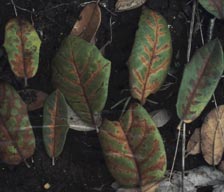How to Identify Oak Wilt in Austin, TX
Venial necrosis, where main veins and lateral veins on leaves become chlorotic and necrotic, is the most reliable way to diagnose Oak wilt in Live Oak. We use Alamo brand fungicide, injected using high volume, Macro-Infusion Technology, as recommended by Texas A&M University. Oak wilt is one of the most destructive tree diseases in the United States. It is a fungus that attacks the vascular system of susceptible trees thereby disabling the water conducting tissue. All Oaks are susceptible, but some are affected more than others. Red Oaks, particularly Spanish Oak (Q.texana), Shumard oak (Q. shumardii), and Blackjack oak (Q. marilandica), are extremely susceptible and play a unique role in new Oak wilt infections. White Oaks, including Post Oaks (Q.stellata), Bur Oak (Q. macrocarpa), and Chinkapin Oak (Q. muehlenbergii), are resistant to the fungus and rarely die from Oak Wilt. Live Oaks (Q. virginiana and Q. fusiformis) are intermediate to susceptibility to Oak Wilt, but are most seriously affected due to their tendency to grow from root sprouts and form vast interconnected root systems that allow movement of the fungus between adjacent trees. The successful management of Oak Wilt depends on correct diagnosis and an understanding of how the pathogen spreads between different Oak species.

